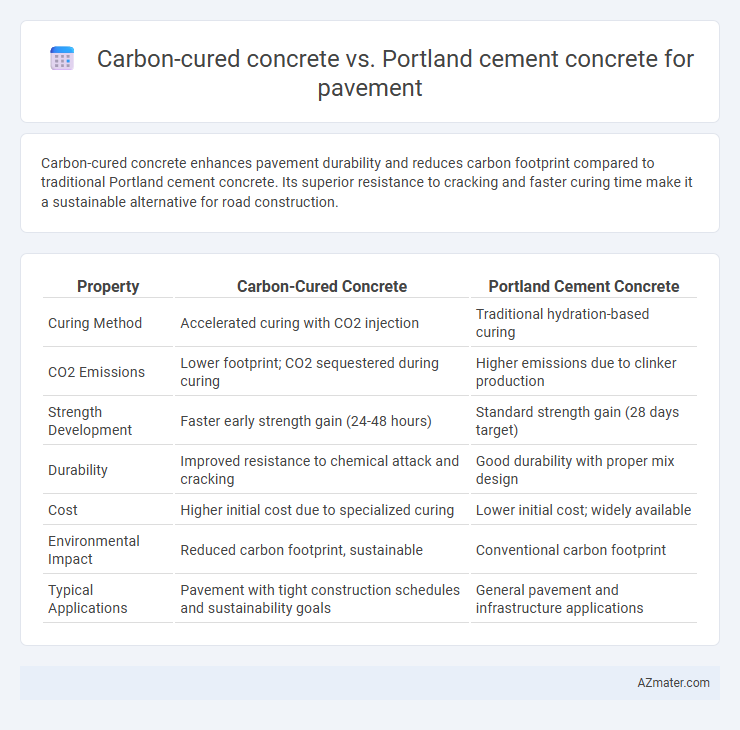Carbon-cured concrete enhances pavement durability and reduces carbon footprint compared to traditional Portland cement concrete. Its superior resistance to cracking and faster curing time make it a sustainable alternative for road construction.
Table of Comparison
| Property | Carbon-Cured Concrete | Portland Cement Concrete |
|---|---|---|
| Curing Method | Accelerated curing with CO2 injection | Traditional hydration-based curing |
| CO2 Emissions | Lower footprint; CO2 sequestered during curing | Higher emissions due to clinker production |
| Strength Development | Faster early strength gain (24-48 hours) | Standard strength gain (28 days target) |
| Durability | Improved resistance to chemical attack and cracking | Good durability with proper mix design |
| Cost | Higher initial cost due to specialized curing | Lower initial cost; widely available |
| Environmental Impact | Reduced carbon footprint, sustainable | Conventional carbon footprint |
| Typical Applications | Pavement with tight construction schedules and sustainability goals | General pavement and infrastructure applications |
Overview of Carbon-Cured Concrete and Portland Cement Concrete
Carbon-cured concrete utilizes accelerated carbonation during curing, enhancing strength and reducing carbon emissions by converting CO2 into stable calcium carbonate, whereas Portland cement concrete relies on hydration of clinker minerals, emitting significant CO2 during production. Carbon-cured concrete offers improved durability and lower environmental impact, making it a sustainable alternative for pavement applications. Portland cement concrete remains the traditional standard due to its established performance, widespread availability, and cost-effectiveness despite higher carbon footprints.
Key Differences in Composition and Production
Carbon-cured concrete incorporates CO2 into the curing process, enhancing strength and reducing carbonation time, while Portland cement concrete relies on traditional hydration of cement and water. The production of carbon-cured concrete involves injecting captured carbon dioxide into precast elements, lowering the carbon footprint compared to Portland cement concrete, which emits significant CO2 during clinker production. Key compositional differences include the use of mineral admixtures in carbon-cured concrete to optimize CO2 uptake, contrasting with the primarily clinker-based blend in Portland cement concrete.
Environmental Impact Comparison
Carbon-cured concrete significantly reduces carbon emissions by utilizing captured CO2 in the curing process, resulting in up to 30% lower greenhouse gas emissions compared to traditional Portland cement concrete for pavement. The carbonation process in carbon-cured concrete not only sequesters CO2 but also improves durability and strength, potentially extending pavement lifespan and decreasing maintenance-related environmental impacts. Conversely, Portland cement concrete production accounts for approximately 8% of global CO2 emissions, primarily due to calcination and fossil fuel combustion, making carbon-cured alternatives a more sustainable choice for reducing the carbon footprint of infrastructure projects.
Strength and Durability Performance
Carbon-cured concrete exhibits enhanced compressive strength and improved microstructural stability compared to Portland cement concrete, resulting in superior load-bearing capacity for pavement applications. The carbonation process densifies the cement matrix, reducing pore connectivity and increasing resistance to freeze-thaw cycles, chemical attacks, and abrasion. This durability advantage leads to longer-lasting pavements with lower maintenance costs and better performance under heavy traffic conditions.
Carbon Emissions and Sustainability
Carbon-cured concrete reduces carbon emissions by capturing and storing CO2 during the curing process, significantly lowering the carbon footprint compared to Portland cement concrete, which emits large quantities of CO2 during production. The carbon sequestration in carbon-cured concrete enhances sustainability by not only reducing greenhouse gases but also improving material durability and lifespan for pavement applications. Portland cement concrete remains a dominant industry standard but faces sustainability challenges due to its high energy consumption and carbon intensity.
Cost Analysis and Economic Feasibility
Carbon-cured concrete generally offers lower lifecycle costs compared to Portland cement concrete due to reduced energy consumption and accelerated curing times, which translate into faster construction schedules and lower labor expenses. Despite higher initial material costs for carbon-cured products, the overall economic feasibility improves with long-term savings from enhanced durability, reduced maintenance, and carbon credit incentives. Cost analyses consistently show that integrating carbon curing technology in pavement projects can be economically viable when factoring in environmental benefits and potential regulatory support.
Installation and Curing Processes
Carbon-cured concrete for pavement utilizes CO2 injection during curing, accelerating strength gain and reducing curing time compared to traditional Portland cement concrete, which relies on hydration requiring longer moisture retention. The installation process for carbon-cured concrete involves precise CO2 delivery systems integrated into curing chambers or on-site environments, enhancing durability and minimizing shrinkage. Portland cement concrete demands extended wet curing periods, typically 7 to 28 days, to achieve optimal strength and durability, while carbon-cured concrete can reach similar performance within days by chemically binding CO2 into the matrix.
Long-Term Maintenance Needs
Carbon-cured concrete significantly reduces long-term maintenance needs for pavement by enhancing durability and minimizing cracking through carbon sequestration technologies. Unlike traditional Portland cement concrete, which is prone to shrinkage and requires frequent repairs and sealing, carbon-cured concrete exhibits improved resistance to wear and environmental stressors. This advanced curing method contributes to lower lifecycle costs and extended pavement service life by reducing surface deterioration and maintenance interventions.
Case Studies in Pavement Applications
Case studies in pavement applications reveal that carbon-cured concrete offers superior durability and reduced carbon footprint compared to traditional Portland cement concrete, demonstrating enhanced resistance to freeze-thaw cycles and chloride penetration. Projects such as the Minnesota Department of Transportation's pilot have shown that carbon-cured concrete pavements achieve comparable or extended service life with lower greenhouse gas emissions. These findings underscore the potential of carbon-cured concrete as a sustainable alternative in roadway construction, balancing performance with environmental benefits.
Future Outlook and Industry Adoption
Carbon-cured concrete offers a lower carbon footprint and faster curing times compared to traditional Portland cement concrete, making it a promising alternative for sustainable pavement solutions. Industry adoption is accelerating as regulatory pressures and infrastructure demands drive investment in carbon capture technologies integrated within concrete production. Future outlook points toward expanded use of carbon-cured concrete in urban and highway projects due to its enhanced durability, reduced environmental impact, and alignment with global climate goals.

Infographic: Carbon-cured concrete vs Portland cement concrete for Pavement
 azmater.com
azmater.com